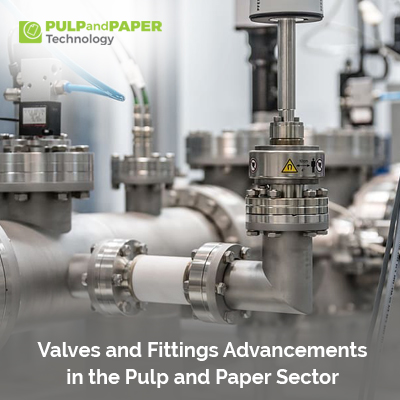Valves and Fittings Advancements in the Pulp and Paper Sector

Introduction
Valves and fittings play a crucial role in the pulp and paper industry, facilitating the flow of liquids, gases, and steam throughout the production process. In recent years, significant advancements have been made in valve and fitting technologies, driven by the industry's growing focus on efficiency, sustainability, and operational excellence. This article explores the latest innovations in valves and fittings, their impact on the pulp and paper sector, and the key benefits they offer.
1. Evolution of Valves and Fittings in the Pulp and Paper Industry
Historically, valves and fittings in the pulp and paper industry have evolved from traditional manual designs to more sophisticated automated systems. Early valves were primarily manual gate valves and globe valves, requiring manual operation for flow control. However, with technological advancements, pneumatic and electric actuators have been integrated into valves, enabling automated control and remote monitoring.
Similarly, fittings have seen a transition from basic connectors to precision-engineered components designed for specific applications. Modern fittings incorporate advanced materials such as stainless steel, carbon steel, and alloys to withstand corrosive chemicals and high pressures commonly encountered in pulp and paper processing.
2. Key Advancements in Valve Technology
a. Smart Valve Systems: The integration of sensors, actuators, and control systems has led to the development of smart valve systems. These systems offer real-time monitoring of flow rates, pressure levels, and temperature, allowing operators to optimize process parameters and detect potential issues before they escalate. Smart valves also contribute to energy savings by adjusting flow rates based on demand.
b. Control Valve Innovations: Control valves play a critical role in regulating flow, pressure, and temperature in pulp and paper processes. Recent innovations include variable speed drives, positioners, and digital control algorithms that enhance precision and responsiveness. Advanced control valves enable tighter process control, leading to improved product quality and reduced waste.
c. Severe Service Valves: In harsh operating environments characterized by abrasive materials and high temperatures, severe service valves offer exceptional durability and reliability. These valves feature robust construction, erosion-resistant coatings, and specialized sealing mechanisms to withstand challenging conditions without compromising performance. Severe service valves are essential for applications such as high-pressure steam systems and chemical processing.
d. Valve Automation and Integration: Automation is a key trend in valve technology, with a focus on seamless integration into overall process automation systems. Automated valves improve efficiency, reduce manual intervention, and enhance safety by minimizing human error. Integration with plant-wide control systems enables data exchange for comprehensive process optimization and predictive maintenance.
3. Innovations in Fittings for Pulp and Paper Applications
a. Corrosion-Resistant Fittings: Corrosion is a major concern in pulp and paper processing due to the presence of acidic and corrosive chemicals. Advanced fittings made from corrosion-resistant materials such as titanium, nickel alloys, and fluoropolymers offer superior protection against chemical degradation, extending equipment lifespan and reducing maintenance costs.
b. High-Pressure Fittings: With the increasing demand for high-pressure systems in pulp and paper mills, high-pressure fittings have become essential components. These fittings are designed to withstand elevated pressures while maintaining leak-free connections, ensuring safe and efficient operation of critical processes such as hydraulic systems and steam distribution.
c. Precision Engineered Fittings: Custom-designed fittings tailored to specific process
requirements are gaining popularity in the industry. Precision-engineered fittings minimize flow restrictions, pressure drops, and turbulence, optimizing fluid flow and enhancing overall system performance. Computer-aided design (CAD) and simulation tools are utilized to develop fittings that maximize efficiency and minimize energy consumption.
d. Environmentally Friendly Fittings: Sustainability is a key focus area for the pulp and paper sector, driving the adoption of environmentally friendly fittings. Eco-conscious fittings incorporate recyclable materials, energy-efficient designs, and waste-reducing features. By reducing resource consumption and environmental impact, these fittings contribute to sustainable manufacturing practices.
4. Benefits of Advanced Valves and Fittings
The integration of advanced valves and fittings in pulp and paper processes offers several benefits:
- Improved Process Efficiency: Enhanced control, automation, and precision result in optimized process parameters, reduced downtime, and increased production efficiency.
- Enhanced Safety: Robust construction, reliable performance, and automated safety features ensure a safe working environment for operators and minimize the risk of accidents.
- Cost Savings: Reduced maintenance, energy savings from optimized operations, and extended equipment lifespan lead to significant cost savings over time.
- Environmental Sustainability: Environmentally friendly materials, energy-efficient designs, and waste-reducing features contribute to sustainable manufacturing practices and regulatory compliance.
5. Future Trends and Outlook
The future of valves and fittings in the pulp and paper industry will continue to focus on innovation, sustainability, and digitalization. Key trends include:
- Integration with Industrial Internet of Things (IIoT) platforms for real-time monitoring, predictive maintenance, and data-driven decision-making.
- Development of smart valves and fittings with advanced diagnostics, self-regulating capabilities, and predictive analytics for proactive maintenance and performance optimization.
- Continued emphasis on materials innovation, including bio-based materials, composites, and coatings, to enhance performance, durability, and environmental sustainability.
- Collaboration between manufacturers, technology providers, and industry stakeholders to drive standardization, best practices, and knowledge sharing for continuous improvement.
In conclusion, the evolution of valves and fittings in the pulp and paper sector reflects a commitment to innovation, efficiency, and sustainability. Advanced technologies offer tangible benefits in terms of process optimization, safety, cost savings, and environmental stewardship, positioning the industry for continued growth and competitiveness in the global market.









